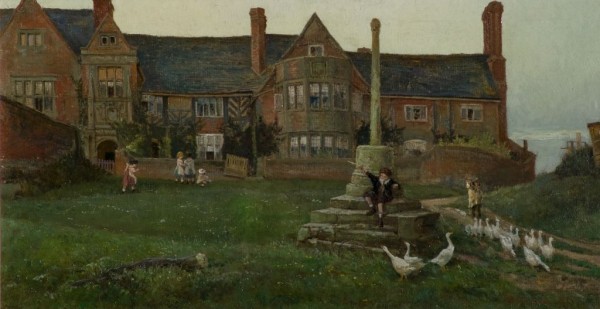Leicestershire Landscapes
Artists have recorded and responded to the Leicestershire landscapes, its towns, villages and buildings for many centuries.

Anstey Bridge pencil drawing by Frederick Landseer (F.L.) Griggs
F.L. Griggs was an artist and draftsman who was interested in recording the historic buildings that were beginning to disappear across the midlands and the south of England. In the 1890s and 1900s he toured parts of England drawing and then printing some of the country's oldest buildings, whether they be churches, houses or farm buildings. A close friend of the Leicester Arts and Crafts designer Ernest Gimson, Griggs recorded many of the county's historic buildings and structures including this view of the packhorse bridge over the Rothley Brook at Anstey. Packhorse bridges were narrow crossings just wide enough for horses carrying goods in baskets or bundles over their backs, but not wide enough for carts or carriages, they form parts of the packhorse routes from major towns and cities to smaller communities who depended on them for the movement of goods and the gossip of packhorse drover.

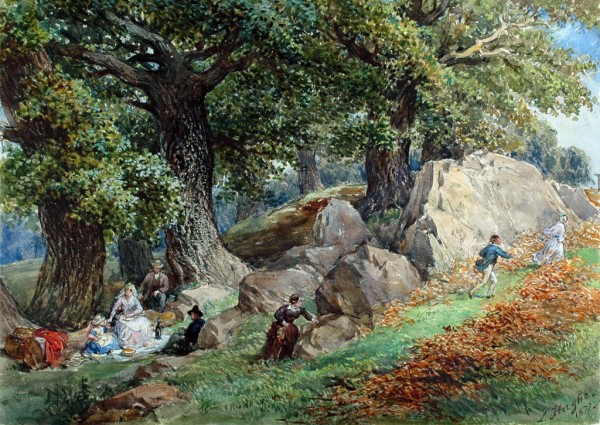
Picnic at Bradgate by L Haghe 1877
Bradgate Park is one of the county's most historic landscapes, its ancient (Precambrian) rocks hold some of the oldest evidence of life in the form of the 'Charnia' fossils. The current park landscape owes much to the fact that it was, from the medieval period, an enclosed Deer Park. The land became the property of the Grey family and Lady Jane Grey was, for nine days, Queen of England. The park began to be open to the public on certain days of the week during the nineteenth century. In 1928 Charles Bennion a wealthy boot and shoe manufacturer gave the park in Trust 'for the enjoyment of the people of Leicestershire'.
This painting dates from the 1877 and shows a group of people having a picnic amongst the park's ancient oaks and rocks. Whilst some of the party eat their meal one of them peeps around the rocks...watching a dapper young man in a blue jacket and smoking cap chasing a young lady in a fashionable white dress, shawl and bonnet. Does romance blossom amongst the rocks?

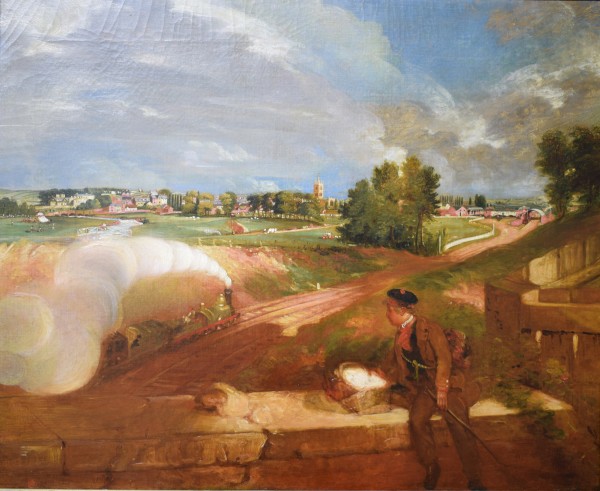
Added to our collection in 2018, this oil painting shows a view of Melton Mowbray with the newly completed railway in the foreground. The actual title, date and artist are unknown.
The first trains from Syston ran into a temporary terminus station at Melton on September 1st 1846. The painting shows Melton station and goods yard apparently complete, so it must have been made a bit later, perhaps in the summer of 1848 when passenger services began over the whole line, from Leicester to Melton, Oakham, Stamford and Peterborough.
In front of the town, on either side of the river, is the open area known generally as Play Close, which has been used as a public open space for many years. Near the road bridge is a marquee, and some figures possibly involved in cricket practice. To the right of the view is the newly-built railway station, apparently complete, with a goods yard with stacks of coal. There appears to be a curved iron roof spanning the tracks. The white buildings beyond are by the canal basin and wharf. The railway builders made a deep cutting through the Mount Pleasant ridge, and in the foreground of the view is one of the parapets of the bridge which carries the road to Great Dalby across the cutting. Two features have been included, probably as a reminder of things which were lost when the railway came. The first is the Melton Mowbray Canal, which ran through the fields between the town and the railway. The second feature is the man in the foreground on the bridge parapet, who appears to be a pedlar. Such people would have travelled from town to town, selling small items to the householders. The railway would soon bring a huge variety of household goods direct from Birmingham or Manchester and elsewhere, to be sold in purpose-built shops. This would gradually take away the pedlar’s business, and within a few years these familiar figures would no longer be seen on the country lanes.

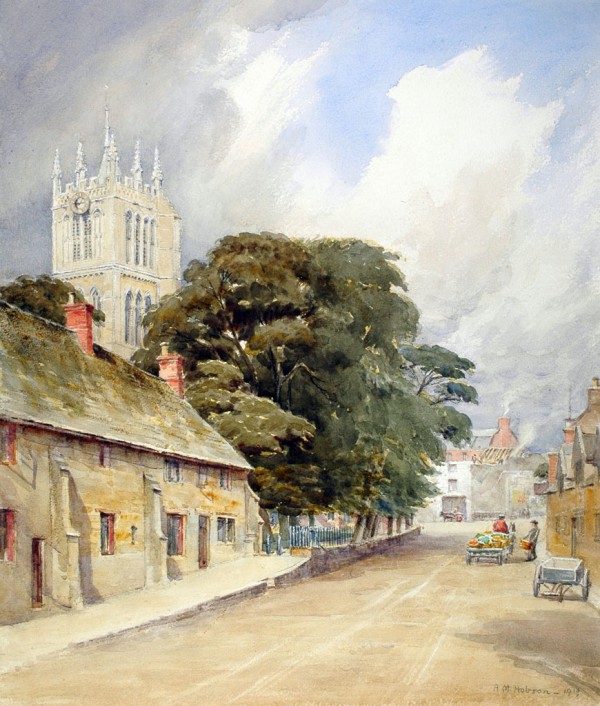
Burton Street, Melton Mowbray by A. M. Hobson 1913
This watercolour view of Burton Street in Melton shows the building known as 'Anne of Cleves' House' (now the Anne of Cleves pub) and the tower of St Mary's church. Painted in the year before the outbreak of the First World War it shows what is now one of Melton's busiest roads without any motor cars or lorries. Even in 1913 the road would have been far busier than the artist has shown it. Melton Mowbray was a thriving and busy market town; a centre for local trade and manufacturing with a market day which would have seen stalls, traders, livestock, customers and street entertainment spilling across the square and along the roads.
The Anne of Cleves house was built in 1384 as a dwelling for the town's Parsons. When King Henry VIII split England's church from Rome church and monastic properties became the property of the Crown and was given to Thomas Cromwell in recognition of his role in reclaiming church properties and making the King enormously wealthy. However, Cromwell fell from favour and this building, along with his other properties were forfeited to the King. Part of Cromwell's downfall was his suggestion that Henry should marry Anne of Cleves - a disastrous marriage which Henry blamed Cromwell for. Whilst Anne received this house as part of her divorce settlement Thomas Cromwell lost more than his property - he was beheaded on Tower Hill in 1540.

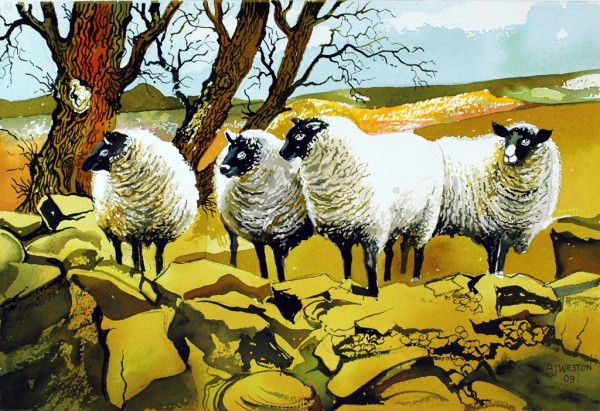
The Sheep, watercolour painting by Ray Weston, 2009.
Sheep have been an important part of Leicestershire's landscape since the Middle Ages. The fleeces of Leicestershire sheep produced fine quality wool that was the basis of much of the county's wealth.
Ray Weston was the head of art and design at Garendon High School before he retired and started to exhibit his work. He has painted many Leicestershire landscapes and we have several of his works in our collections.

Some images were created as a record; some as an interpretation, some capture a moment in time when the county was changing or when buildings were disappearing. Some of the pictures show how different artists have captured the same place over a period of time whilst others are the only artistic image that we have of somewhere. In our collections you will see some well known places that looked much the same as they do today...whilst others have been completely transformed since the artist first committed them to paper or canvas.

